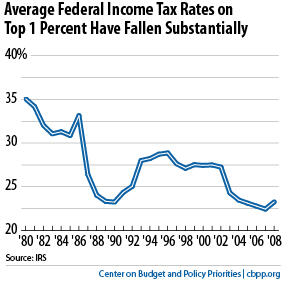When billionaire investor Warren Buffet recently called on policymakers to “get serious about shared sacrifice” by raising taxes on the nation’s wealthiest people, some critics claimed that this wouldn’t make a serious dent in our budget problems. Nonsense.
IRS data show that the top 1 percent of taxpayers had a combined income of $1.7 trillion in 2008, the most recent year available. This is fully 20 percent of the nation’s total adjusted gross income — and much more than the bottom
half of the population had (around 13 percent).
Moreover, the tax burden at the top of the income scale has fallen dramatically in recent decades. IRS data show that the top 1 percent of taxpayers paid an average of about 23 percent of their income in federal income taxes in 2008. That’s far below what they paid prior to the Bush tax cuts, and about a third less than they paid back in 1980 (see graph).
Returning the average tax rate on the top 1 percent of taxpayers to its 1996 level of 29 percent could raise about $100 billion a year, or $1 trillion over the next decade.
By itself, of course, that wouldn’t solve the country’s long-term fiscal problems. Spending restraint, particularly in the health area, will also be needed, and taxes on other Americans will have to go up as well. But $1 trillion over ten years is real money and would make a real dent in the deficit.

